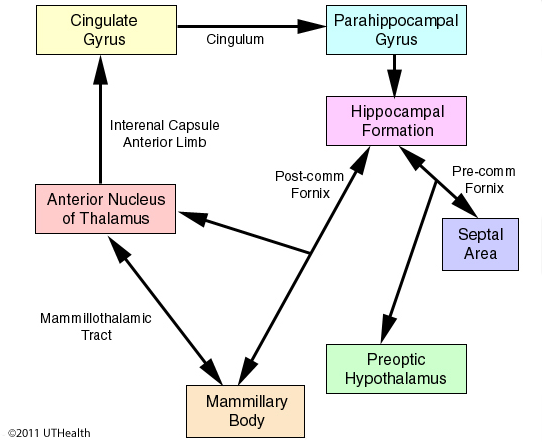Lab 11 - The Limbic System
Subcortical Structures of the Limbic System
 The hippocampal formation is considered to be important for the transfer of recently acquired information (memory) into a more enduring form (long-term memory). It receives input from the entorhinal cortex of the parahippocampal gyrus, septal nuclei, and hypothalamus. The input from the entorhinal cortex "relays" information from the olfactory system, cingulate gyrus, orbital cortex, amygdala and temporal cortex. The fornix is an efferent tract of the hippocampal formation. It travels from the hippocampal formation to the septal nuclei, preoptic hypothalamic areas, anterior (A) thalamic nucleus and mammillary bodies.
The hippocampal formation is considered to be important for the transfer of recently acquired information (memory) into a more enduring form (long-term memory). It receives input from the entorhinal cortex of the parahippocampal gyrus, septal nuclei, and hypothalamus. The input from the entorhinal cortex "relays" information from the olfactory system, cingulate gyrus, orbital cortex, amygdala and temporal cortex. The fornix is an efferent tract of the hippocampal formation. It travels from the hippocampal formation to the septal nuclei, preoptic hypothalamic areas, anterior (A) thalamic nucleus and mammillary bodies.
The pathway involving the hippocampal formation and septal nuclei is a cholinergic pathway. It is important clinically because it has been suggested that alterations in this pathway may be associated with Alzheimer's disease. The hippocampal pathway to the anterior thalamic nucleus and mammillary bodies involves the hippocampal formation in a neural "circuit" proposed by James Papez to be important in emotional feeling and expression; however, more recent anatomical evidence suggests that the original proposal is an oversimplification of limbic connections.
The anterior thalamic nucleus gives off thalamocortical projection fibers, which pass via the anterior limb of the internal capsule to the cingulate gyrus. From the cingulate gyrus, axons pass into the cingulum. The fibers of the cingulum project into the temporal lobe and terminate mainly in the cortex of the parahippocampal gyrus. From the parahippocampal gyrus fibers make synaptic connections in the hippocampal formation. This circuit, fornix, mammillothalamic tract, cingulum is historically known as Papez's circuit (pronounced papists).
